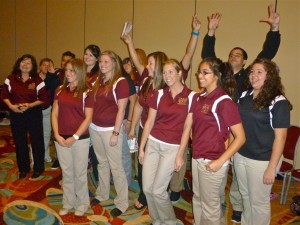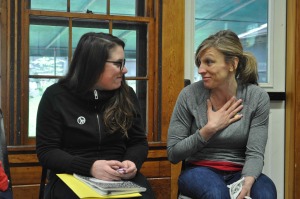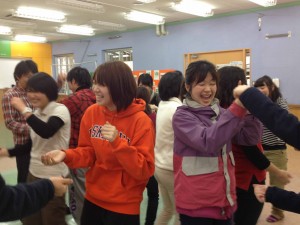Sep 19, 2016 Setting the Tone: Creating a Positive Environment for Learning
This is an updated version of a previous post entitled “Optimal Ingredients for Effective Group Facilitation” rewritten for the new edition of Tips & Tools for the Art of Experiential Group Facilitation to be released in October.

A fundamental aspect of effective group programming is taking the time to help participants create a positive, supportive environment in which they can share and work together. It can be risky for people to try new activities and share ideas, reactions, and opinions with a group. Research on the brain and learning suggests that individuals participate in activities and retain lessons more readily when they feel safe and supported in their learning environment (Willis, 2014). So be intentional about how, when, and where you engage group members from the very start of a program.
Time spent up front consciously and carefully planning activities that build a group’s comfort level will pay off later. Allow individuals to explore the novelty of experiential group-work with a sense of ownership and control. Participants need to feel that the activities they are participating in or the materials they are learning are useful and relevant to their goals. Effective facilitators start this process before groups even walk through the door.
Recipe for Building a Positive Group Environment
Facilitation is like cooking. When you first start cooking, you follow the tried-and-true recipes from family, a friend or colleague, or a cookbook. As your skills increase, you start to improvise and vary the ingredients. Successful facilitators vary ingredients all the time to keep things interesting or to “spice up” their group work, but they always keep in mind the key ingredients that make it happen. There is a lot of room for creativity, style, and adaptation in cooking, but key rules and ingredients are needed in order for a cake to rise or a sauce to thicken. Facilitators must balance the parameters of the situation, the needs of the group, and their own creativity and style.
Key Ingredients for Creating Positive Learning Environments
• Start with style! Set the tone with appropriate beginning activities that include a welcome or hook to engage the group in introductions, rapport-building, and goal-setting. Take time for this process. Sharing commonalities develops trust and empathy. When people are given an opportunity and the time to share in a comfortable way, they build the capacity for more in-depth interaction later in group development.
• “Hook” your group with a welcoming activity that draws their attention to the present, creates context, and begins the process of group building and reflection. Research from educational psychology shows that people best remember the first few moments and the last few moments of an experience (Sousa, 2006; Willis, 2010). Take advantage of these key moments for engaging groups.
• Make thoughtful activity choices. Create an opportunity for people to meet and greet in a non-threatening way to help dispel fears about group process or being put on the spot. Choose activities that build rapport, camaraderie, shared understanding, and commonalities in an incremental, organic way. Beware of opening activities that could be intimidating. Brain research shows that though we do learn from a degree of novelty and challenge, comfort and trust has to be built first.

• Begin with partner sharing activities. This gives participants an opportunity to warm up by interacting with just one or two others before sharing with a larger group. Building trust in this way allows participants to engage and share at their own pace and, over time, become willing to push their comfort zones.
•Learn and honor names. People’s names are important to them and should be honored with correct pronunciation and proper use to build trust, positive communication, and a
supportive environment. Weave name activities and practice into introductory experiences starting with simple partner greetings and sharing before engaging participants in whole-group name activities. Avoid contrived name activities that put people in the spotlight or require them to feel under pressure to memorize.
• Keep an eye on time parameters and plan accordingly. It takes time to sequence and build healthy trust. Time and experience together bring comfort to sharing thoughts, ideas, and feelings. Set aside time for the reflective aspect of learning. Be patient with the group development pace. Time spent up front building trust and reflective skills pays off later!
• Consider the physical environment when planning or evaluating group experience. Intentionally select the environment and arrange seating based on the goals and needs of the group.
• Create opportunities for participants and facilitator to share clear expectations and goals for the program. This clarification of goals and context-setting for the program can be woven
organically into the hook activities and icebreakers used to begin your program.
• Give participants choice and control. People learn best when they perceive a sense of control and have choice and ownership in learning experiences. Empowering participants to set reasonable parameters around their participation creates an atmosphere of healthy trust. Knowing they can say no, or pass, will actually increase involvement from reluctant participants. Facilitators often aim to create change by pushing comfort zones and creating disequilibrium; however, there is a fine line between positive disequilibrium and a potentially damaging experience.
• Establish and reflect on healthy group norms. Facilitator imposed ground rules should be put forward from the start, but meaningful group norms can only truly be created by the group as they encounter challenging situations together. Help group members create an environment in which they feel responsible for themselves and each other. A supportive atmosphere will allow them to speak up when there is a breakdown in communication or an issue that affects the safety or potential experience of the group.
• Intentionally sequence activities to build the capacity of trust over time. (Time means something different in relevant terms for a one-day program than a year-long program.)
• Take into consideration the differing needs, personalities, and backgrounds of participants. Practice reflection to bring learning to life. Intentionally making time for participants to reflect and regularly checking in creates opportunities to share what is working, what they need from each other, and to celebrate successes along the way. Experiences can then build upon one another and more clearly relate to real life and future learning. Reflective practice is best when it is a dynamic, ongoing part of your programs, not just something facilitated at the end of an experience or as a follow-up.
References:
Sousa, D. (2006) How the brain learns. Thousand Oaks, CA: Sage Publications
Stanchfield, Jennifer (2016) Tips & Tools for the Art of Experiential Group Facilitation Second Edition. Bethany, OK: Wood N Barnes Publishing.
Willis, J. (2010) Understanding and planning achievable challenge. Learning to love math-teaching strategies that change student attitudes and get results (pp. 16-32). Alexandria, VA: ASCD
Willis, J. (2014) “Brain-based teaching to improve executive functioning.” Lecture conducted at The Learning & the Brain Conference: Engaging 21st Century Minds. Boston, MA.



No Comments